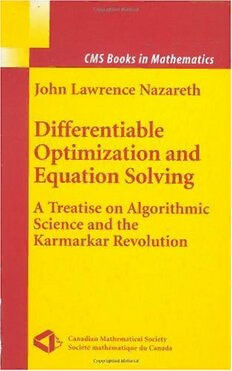
Differentiable optimization and equation solving: A treatise on algorithmic science and the Karmarkar revolution PDF
Preview Differentiable optimization and equation solving: A treatise on algorithmic science and the Karmarkar revolution
Differentiable Optimization and Equation Solving: A Treatise on Algorithmic Science and the Karmarkar Revolution John Lawrence Nazareth Springer Canadian Mathematical Society Soci´et´e math´ematique du Canada Editors-in-Chief R´edacteurs-en-chef Jonathan Borwein Peter Borwein Springer NewYork Berlin Heidelberg HongKong London Milan Paris Tokyo This page intentionally left blank John Lawrence Nazareth Differentiable Optimization and Equation Solving A Treatise on Algorithmic Science and the Karmarkar Revolution With 14 Illustrations 1 Springer John Lawrence Nazareth and Professor Affiliate Professor Department of Pure and Applied Department of Applied Mathematics Mathematics University of Washington Washington State University Seattle, WA 98195 Pullman, WA 99164-3113 USA USA [email protected] Editors-in-Chief R´edacteurs-en-chef Jonathan Borwein Peter Borwein Centre for Experimental and Constructive Mathematics Department of Mathematics and Statistics Simon Fraser University Burnaby, British Columbia V5A 1S6 Canada [email protected] MathematicsSubjectClassification(2000):34G20,65K05,68Wxx,90C05,90C30 LibraryofCongressCataloging-in-PublicationData Nazareth,J.L.(JohnLawrence) Differentiableoptimizationandequationsolving:atreatiseonalgorithmicscience andtheKarmarkarrevolution/JohnLawrenceNazareth. p. cm.—(CMSbooksinmathematics;13) Includesbibliographicalreferencesandindex. ISBN0-387-95572-0(alk.paper) 1. Mathematicaloptimization. 2. Programming(Mathematics) 3.Algorithms. I. Title. II. Series. QA402.5.N3752003 519.3—dc21 2002030238 ISBN0-387-95572-0 Printedonacid-freepaper. (cid:1)c 2003JohnLawrenceNazareth Allrightsreserved.Thisworkmaynotbetranslatedorcopiedinwholeorinpartwith- outthewritten permission ofthepublisher (Springer-Verlag NewYork,Inc.,175Fifth Avenue, New York, NY 10010, USA), except for brief excerpts in connection with re- viewsorscholarlyanalysis.Useinconnectionwithanyformofinformationstorageand retrieval, electronic adaptation,computer software,orbysimilar ordissimilar method- ologynowknownorhereafterdevelopedisforbidden. Theuseinthispublicationoftradenames,trademarks,servicemarks,andsimilarterms, eveniftheyarenotidentifiedassuch,isnottobetakenasanexpressionofopinionas towhetherornottheyaresubjecttoproprietaryrights. PrintedintheUnitedStatesofAmerica. 9 8 7 6 5 4 3 2 1 SPIN10891209 Typesetting:PagescreatedbytheauthorusingaSpringerTEXmacropackage www.springer-ny.com Springer-Verlag NewYork Berlin Heidelberg A member of BertelsmannSpringer Science+Business Media GmbH To my parents, John Maximian Nazareth (in memoriam) and Monica Freitas-Nazareth This page intentionally left blank Preface In 1984, N. Karmarkar published a seminal paper on algorithmic linear programming. During the subsequent decade, it stimulated a huge out- pouringof newalgorithmicresultsby researchersworldwidein many areas of mathematical programming and numerical computation. Thismonographgivesanoverviewofaresultingdramaticreorganization thathasoccurredinoneoftheseareas:algorithmicdifferentiableoptimiza- tion and equation-solving, or, more simply, algorithmic differentiable pro- gramming. A new portrait of this field has emerged in recent years, which is summarized in the opening chapter and then considered, in more detail, in subsequent chapters. The primary aim of this monograph is to provide a unified perspective andreadablecommentaryontheabovesubject,withemphasisbeingplaced ontheproblemsthatformitsfoundation,namely,unconstrainedminimiza- tion, solving nonlinear equations, the special case of unidimensional pro- gramming,andlinearprogramming.Theworkdiscussedherederives,inthe main,fromtheauthor’sresearchintheseareasduringthepost-Karmarkar period, and the focus of attention throughout the monograph will be on the following topics: • the formulation of root-level algorithms with a view to developing an understandingoftheirinterrelationshipsandunderlyingmathematical substructure; • the illustration of their performance via basic computational experi- ments on a mix of contrived and/or realistic test problems; viii Preface • a consideration of larger issues that center on the emerging discipline of algorithmic science. For a detailed overview, see Chapter 1 and, in particular, Section 1.3. The convergence-and-complexity analysis of optimization and equation- solvingalgorithmsconsideredhereisimportantfromamathematicalstand- point.However,thisfacetofthesubjectdoesnotliewithinourmainsphere of interest and it is treated only very briefly. The interested reader can find an in-depth and up-to-date background discussion in several recently published books, for example, Bertsekas [1999], Blum, Cucker, Shub, and Smale [1998], and Kelley [1999]. For additional background perspective on convergence analysis, see also Powell [1991]. The reader is assumed to be familiar with advanced calculus; numerical analysis,in particular,numericallinearalgebra;thetheoryandalgorithms of linear and nonlinear programming; and the fundamentals of computer science,inparticular,computerprogrammingandthebasicmodelsofcom- putation and complexity theory. Thus, this monograph is intended for re- searchers in optimization and advanced graduate students. But others as well will find the ideas to be of interest. The book can be used for self-study, as a research seminar text (accom- paniedbyselectedreadingsfromthecitedliterature),orasasupplementto a comprehensive graduate-course textbook on optimization and equation- solving, for example, Bertsekas [1999]. A variety of open avenues of algo- rithmicresearcharehighlightedinmanyofthechapters,whichcanprovide the basis for research projects in a seminar or graduate course. And if the typicalreadercomesawaywitharefreshing,newperspectiveonalgorithmic differentiable programming and an appreciation of the joys of algorithmic science1 ingeneral,thenmyobjectivesinwritingthismonographwillmore than have been fulfilled. Ifeelveryfortunatetohavebeenabletoparticipateinthepost-Karmarkar algorithmic revolution. It was an extremely interesting and exciting time and afforded the opportunity to interact with many researchers who ac- tively contributed to it. I have also been very fortunate to have known some of the great pioneers in the field of algorithmic differentiable opti- mization and equation-solving, who discovered its fundamental algorithms and havebeen asource of inspirationto allthat followed them. I thank,in particular, three algorithmic scientists par excellence, who exemplify the field: Emeritus Professors George Dantzig (simplex; decomposition), Bill Davidon (variable-metric; collinear-scaling) and Al Goldstein (gradient- projection; cutting-plane). 1Webster’s dictionary defines the word “treatise” (on algorithmic science), which isused inthe subtitle ofthe monograph, asfollows: “asystematic exposi- tion or argument in writing, including a methodical discussion of the facts and principles involved and the conclusions reached.” Preface ix IthanktheMathematicalSciencesResearchInstitute(MSRI),Berkeley, California, and, in particular, Professors Michael Overton, Jim Renegar, and Mike Shub, for the invitation to participate as a member of the fall 1998PrograminOptimization.Thiswritingwasbeguntherewithsupport from MSRI. SomeoftheworkdescribedinChapter3wasdonejointlywithProfessor Liqun Qi (University of New South Wales, Sydney), and the algorithm in Chapter 6 was developed jointly with Professor Paul Tseng (University of Washington). I thank them both for the interesting collaboration. I’m very grateful to the University Relations Committee of the Boeing Company,Seattle,Washington,andespeciallytoRogerGrimes,forprovid- ing seed funding for an algorithmic science feasibility study (1999–2000). Its underlying idea has roots that can be traced all the way back to my graduate studies in the Departments of Computer Science and IE&OR at Berkeley (1968–1973), and I thank my research advisors Professors Beres- ford Parlett and Stuart Dreyfus for their wise counsel during and after these formative years. I gratefully acknowledge my home Department of Pure and Applied Mathematics, Washington State University, Pullman, and my affiliate De- partmentofAppliedMathematics,UniversityofWashington,Seattle,and, in particular, Professors Mike Kallaher, Bob O’Malley, Terry Rockafellar, and K.K. Tung, for providing nurturing and collegiate research environ- ments. A sabbatical leave (2000–2001), which was spent at this interface, gave me the opportunity to do much of the writing and bring the work to completion. I also thank Professor Jonathan Borwein of Simon Fraser University and Mark Spencer, Margaret Mitchell and Jenny Wolkowicki of Springer-Verlag, New York, for facilitating the book’s publication. Finally, a special thanks to my wife, Abbey, for her encouragement and helpful advice on this project, and, more importantly, for the joy that she brings to life. John Lawrence Nazareth Bainbridge Island, 2002
